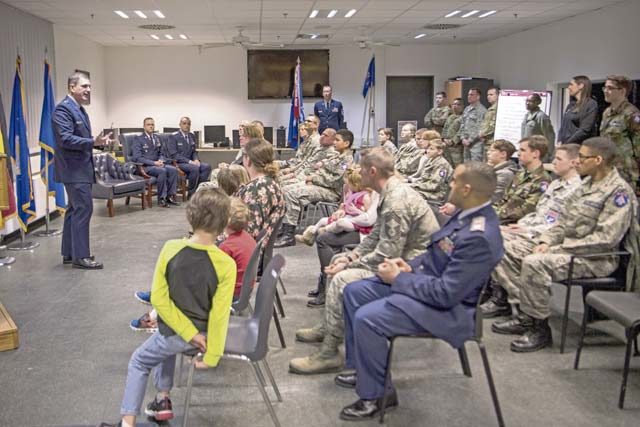
Every organization in the U.S. Air Force has a set of Air Force Instructions that provide a framework for how the unit should function. As an official civilian auxiliary of the U.S. Air Force, Civil Air Patrol guidelines were created specifically for stateside units. For the Ramstein Cadet Squadron, being overseas leaves a lot of room to find a way to solve their unique challenges.
The Ramstein Cadet Squadron was established in 1987 and is the second-oldest, continuously operating organization on Ramstein. The Ramstein Cadet Squadron is the largest overseas squadron and now has more than 100 personnel.
Cadets range from 12 – 21 years old and senior members are 18 and up. CAP squadrons train members in cadet programs, Aerospace education, and training in emergency services. This gives cadets a chance to learn leadership skills and develop an interest in aviation related careers. The training also teaches them skills they need to serve the emergency services functions of the CAP, including aiding in search and rescue, and disaster relief operations. Many training opportunities and capabilities are limited for units operating overseas.
Master Sgt. Michael Livesay, 721st Aircraft Maintenance Squadron production supervisor, is also a Civil Air Patrol Major who recently relinquished command of the local unit. He said one of the challenges he faced was securing space to conduct the annual training encampment. But, he said U.S. Air Force units like the 86th Airlift Wing, 435th Air Ground Operations Wing, 521st Air Mobility Operations Wing, and others in the Kaiserslautern Military Community take a total force approach to supporting the local unit.
“The 435th Construction and Training Squadron compound gave us the capability to hold the encampment at the CTS training grounds,” said Livesay. “We put the cadets out in the field for seven days. They have so much fun that whole week. It’s a highlight of their summer, and their time in CAP.”
The Ramstein Cadet Squadron created a training conference for senior members to further their career development and volunteers from the 521 AMOW and 435 AGOW trained junior cadets during the encampment.
“We had two prior basic military training instructors go out and had a wonderful interaction with the cadets,” said Livesay. “The training they gave as instructors was scaled perfectly for the cadets.”
Brig. Gen. Mark R. August, 86th Airlift Wing commander, allows cadets and their families to tour the base and participate in open house visits with units on Ramstein Air Base. With such a large organization the CAP unit has to navigate transportation and logistics. The unit cannot permanently have a government owned van.
“Every year we get bigger and bigger, and we have to figure out how to move these cadets,” said Livesay. “We worked with 86th Vehicle Readiness Squadron to get a bus to move our cadets on time.”
The group visited with the 24th Intelligence Squadron to fulfil the aerospace mission to allow cadets to meet U.S. Airmen who work in aerospace and engineering careers and ask questions about the work they do to generate interest in the career field.
One of CAP’s notable training opportunities is the chance for cadets to fly single engine aircraft and gliders. Livesay says every cadet who joins stateside gets five seat rides in a powered air craft and five in a glider. The cadets meet specific training objectives with each ride.
“CAP stateside has the largest fleet of Cessna aircraft in the world,” said Livesay. “Overseas, we’re not allowed to have any aircraft. So we work with a local aero club, and our national headquarters, and figured out how to coordinate everything to get cadets their orientation flight.”
Because of their efforts the organization has been able to spread the capability across the European theatre and helped members from Wiesbaden, Ramstein, Stuttgart, Spangdahlem, and Mildenhall accomplish orientation flights. Livesay says through trial and error, the cadet squadron has redefined what it means to be an overseas CAP unit.
“Someone asked me what my proudest achievement when I was in command I think it was pushing the envelope,” said Livesay. “You can’t keep them in the box. They will always find some way to push it out. ‘You can’t do this?’ Well, why not?”
They are the first overseas squadron to receive the quality cadet unit award two years in a row and were also awarded their fourth unit citation.


